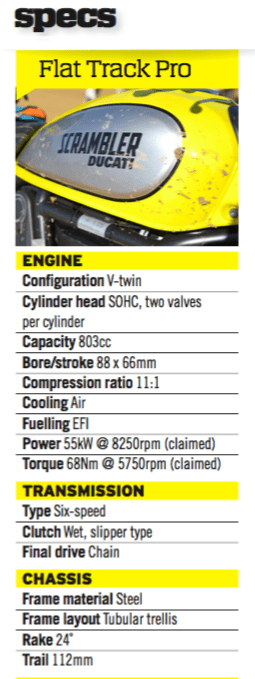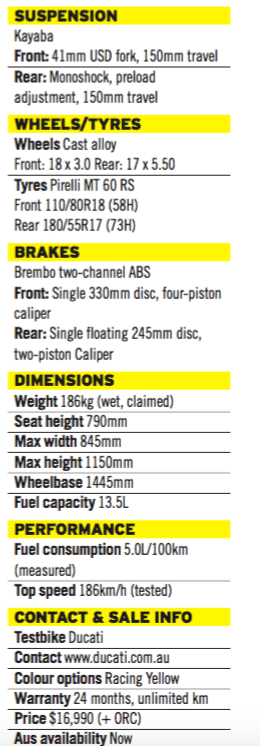Ducati Scrambler Flat Track Pro – Let’s talk about your lifestyle. How dirty is it? Plenty of rough stuff in the diet? Not that Ducati, until recently would really have been concerned about you and dirt, mud, dust or any other fun off-road by-products. You see, in just a few short years the classy Italian marque has broken free of its stereotypical sportsbike and naked themes, and has worked out that getting the front of your beautifully sand-casted engine smothered in mud or banking on your mate and copping a roost of the pooh-coloured thick stuff isn’t too tough on Ducati’s image – or yours. In fact, it’s a wonderful thing, in a dirty but wholesome way.
The Scrambler range has already hinted at some extra-circular activities. From the introductory 400cc Sixty2 to the base model 803cc Icon, the wire-wheeled Urban Enduro and Classic right through to the Full Throttle (the cousin of this Flat Track Pro), all give a soft promise of old-school enduro hijinks. And since then Ducati has delivered on the promise in style with the Multistrada Enduro 1200 and this Pro model, as well as a range of dirt-riding gear in the catalogue.
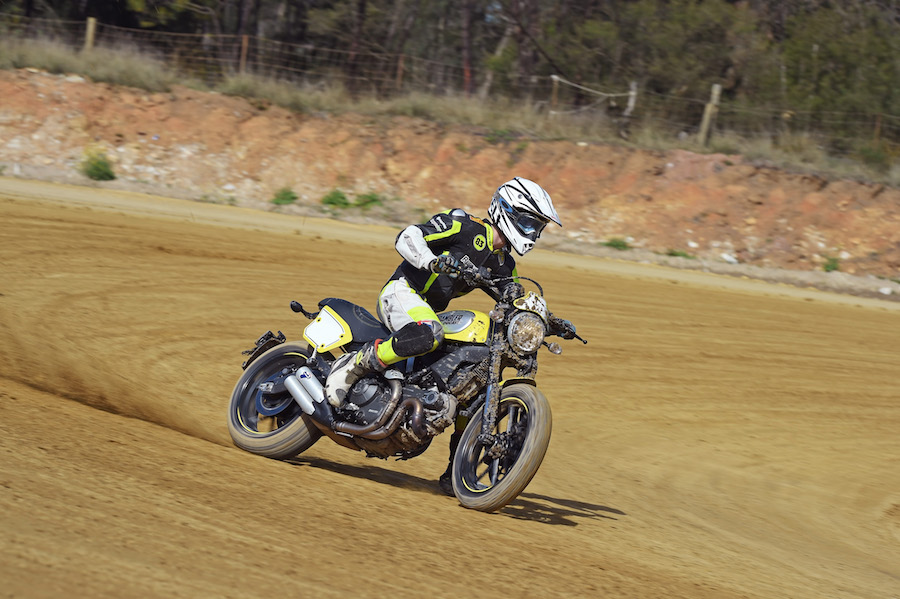
There is a model to suit almost any taste and budget if you are chasing the urban-retro look, starting at $11,990 for the Sixty2, ranging through to the Icon at $13,290 and the Classic, Urban Enduro and Full Throttle at $15,490 and the Pro at $16,990 (all + ORC). At almost double the retail price, the Multistrada Enduro at $29,990 (+ ORC) is an expensive way to get dirty compared to the Pro.
What makes the Flat Track Pro especially attractive is the added gear over its siblings, converting it from a streetwise retro bike into more of a high-speed long tracker from the good ol’ US of A. The bright fluoro yellow paint, Termignoni slip-ons, low tapered handlebars, the front brake fluid filler cap in billet aluminium, dedicated seat, nose fairing, rear plate holders, footpegs and mirrors in billet aluminium, the funky grips, short front mudguard, rear indicator support, and alloy wheels with yellow piping on the rims … all these things set it apart and gives the Yella-Terra a more aggressive, younger person’s look. Onya Troy Bayliss for that!
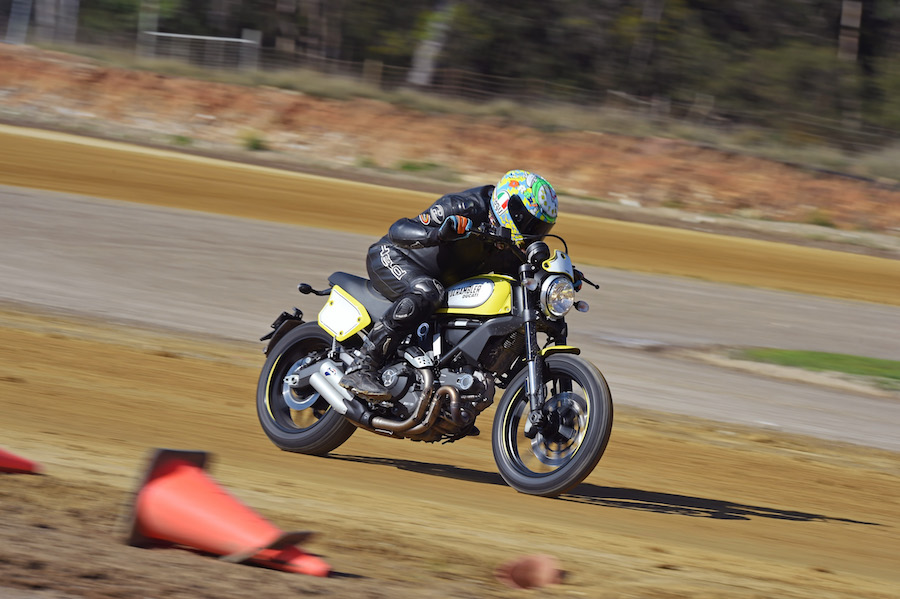
After a week of commuting and a spot of two-up touring, the Pro could not be dissed for its ample punch and comfort (even if a rear rack would be a useful addition) and a relaxing gait that 90º twins are known for. Then it was time to nervously head south to the Appin track and experiment in a new kind of dirtiness. We dropped the pressure on the Pirelli MT 60s, removed the mirrors and set about finding out if the wheel-spin matched the Ducati marketing spin, and whether the bright fluoro yellow number plates and the all the accompanying bling would still look good after a morning going around in fast anticlockwise circles. Oh, we also spent an inordinate amount of time switching off the ABS. This isn’t a simple ‘press the button and in a split second you are backsliding the 17-incher’. No. It’s a pain in the berm, so most of the time I just let Bosch do its thing.
I’m a total newbie to flat track riding, although there is a crossover to trials riding as you lose the front end during every steering input and get the back end stepped out on the exit. Plentiful, meaty grunt guarantees that! On the dirt and loose trails, drawing a little on adventure touring and enduro riding helps to at least reduce the fear, but it doesn’t change the fact that the Ducati is a bit of a show pony. Keep calm and slide on!
Short circuit work (more fun than work) is about making a mistake, then returning to the scene 30 seconds later to work out why the last rotation was so close to a disaster, and then correcting it another 30 seconds later. Both horsepower and wheel spin are delivered vigorously, which means those half minutes are swallowed up quicker than you can scream ‘this is insane’ and ‘let’s find some steel soles for my left boot!’
Flat track means flat as in no bumps –the surface is constantly dressed and watered then rolled. But while a flat line eventually develops, you still have to find a way through treacherously skittish loose stuff. I was glad that the Pro comes fitted with 150mm of suspension travel front and rear as you would think that would be plenty of room to soak up most road bumps as well as Appin’s smooth granular surface. Not quite. The Italian/Ducati trait of stiffness is in effect, and after the initial subtle hit then they firm up markedly through the remaining stroke. They work well on the track but on the road you’ll never forget the ‘made in Italy’ badge. Combined with too high gearing and a reluctance to turn, I was going to eat a lot of wet sticky mud and sand if I thought I could ride like Troy.

The Ducati comes with the logically fitted 18-inch front and 17-inch rear. This combo is decent and stable enough, but if you really want to bend it like Bayliss, the flat track gurus say 19-inchers front and rear is the way to go.
Ducati intentionally – or maybe by completely fluking an engineering feat – has built into the chassis something I can’t recall experiencing. Most motorcycles love a positive throttle. They feel at their best, like a pig in mud, with the front end lifted up slightly, the chain with the right amount of critical tension and the engine loading up from the combustion chamber all the way through to the gearbox and eventually to the rear tyre. This suited Appin’s flat straights that lead into slightly banked turns. But away from the track, while rolling down to the lights, or even touring, I kept thinking that something was strange here, very strange. Throttle off and the Scrambler didn’t come across any worse (or better). The weight transferred to the front, the engine – without any load and the chain not driving it – didn’t make sense … and then I caught a look at myself as a shadow on the road. Oh those sly Ducati engineers! They have built in the ability to enjoy this bike in almost every attitude: accelerating, cruising or decelerating. And that means you can spend more time looking at yourself in the windows of the shops. How endearingly Italian, and so egocentric too!

This is also a benefit on the dirt. Maybe as a consequence, the steering angle which works on the road thankfully works on the flat track, meaning the Ducati feels lively but gives plenty of feedback. Young Locky (see breakout) said that the Pro had the right amount of steering lock to get the rear wheel stepped out to the international standard he is at. Me? I could at least drift the rear wheel out far enough and survive to ask ‘where are the wire wheels?’
Brakes are the least analog thing on the whole Scrambler package with Bosch 9.1 MP AMS control taking care of proceedings. No chance of underwhelming discs front and rear bringing you undone with a single 330mm at the front and a more than adequate 245mm at the back. This is the type of mid-range capacity motorcycle that doesn’t need anything more complicated than premium fuel in its 13.5-litre tank.
So, is the Ducati is dirty enough for this kind of action or should it remain the preserve of hipsters and commuters? I would have to say the Pro surprised most of us at Appin that day.
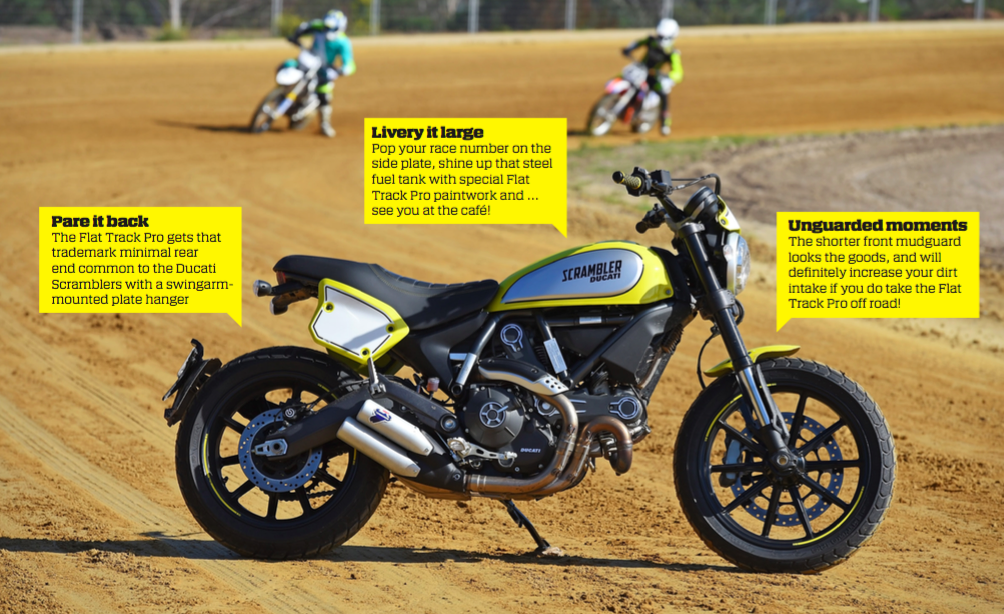
On either side of the track blast I did a thousand kilometres of commuting including freeway riding and a two-up 300km round trip for a sunny lunch date with friends. All this was accomplished with minimal numb bum(s) and very economical hit to the wallet. The fuel range matches the amount of tarmac I could manage in one hit – about 220km. If the Scrambler was your only means of transport you could almost hand in your BMW Touring Club memberships, get a set of soft bags and strap a bag on the rear seat and go touring.
As a wannabe image machine the Scrambler Flat Track Pro has the silhouette of a racer and the credentials of a fine blasting motorcycle. I added some dirt into my diet and the extra time in the local wash bay, and definitely felt better for it. It’s all good clean fun.
